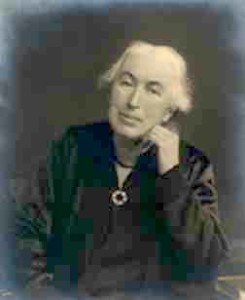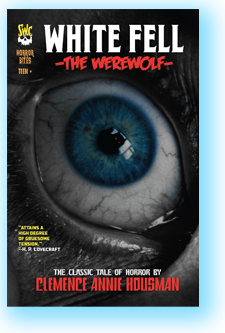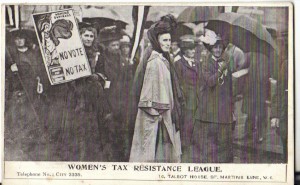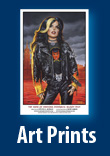 As ’Warp fans are aware, on February 7th we launched our new SWC Horror Bites chapbook series (“short tales to appease your monstrous hunger for suspense”) with White Fell—The Werewolf, the classic horror tale by renowned author, artist, and suffragette Clemence Annie Housman. Today, as part of our recognition of February being Women in Horror Month, I thought it would be the perfect time to take a closer look at Ms. Hosuman and her work.
As ’Warp fans are aware, on February 7th we launched our new SWC Horror Bites chapbook series (“short tales to appease your monstrous hunger for suspense”) with White Fell—The Werewolf, the classic horror tale by renowned author, artist, and suffragette Clemence Annie Housman. Today, as part of our recognition of February being Women in Horror Month, I thought it would be the perfect time to take a closer look at Ms. Hosuman and her work.
Born on November 23, 1861, in Bromsgrove, Worcestershire, England, Clemence was one of six children born to Edward and Sarah Jane Housman; one younger brother, Laurence, would grow up to become a writer and illustrator, while their older brother Alfred would later be known as the famous poet A. E. Housman. In 1883, Clemence began attending the South London School of Technical Art, where she learned engraving, which would prove useful for her artistic career.
Her first novella, The Were-wolf, debuted in 1896 from London-based publisher J. Lane at the Bodley Head; illustrations were provided by Laurence. A tale of twin brothers put at odds to each other by the arrival of a mysterious woman in their village, it was praised by critics—among them H.P. Lovecraft, whose work, especially his Cthulhu Mythos stories, has inspired generations of horror writers. In his lengthy examination of the genre, “Supernatural Horror in Literature” (first published in 1927), he remarked:
“Clemence Housman, in the brief novelette ‘The Were-wolf’, attains a high degree of gruesome tension and achieves to some extent the atmosphere of authentic folklore.”

Clemence Housman (in gray, 3rd from right) at a suffragette gathering. Photo courtesy of Schwimmer-Lloyd collection, NYPL
But it was her work outside literary circles that brought Clemence the most attention and praise, particularly her efforts in the suffrage movement to gain voting rights for women in the United Kingdom. In 1909, she and Laurence, along with cartoonist Alfred Pearse, founded the political organization/publication Suffrage Atelier; a majority of its members were women who, like Clemence, were professional illustrators. She was also a member of the leading suffrage organization, the Women’s Social and Political Union (WSPU), and the Women’s Tax Resistance League. Clemence also gained attention by being, in September 1911, the first woman imprisoned by the British government for nonpayment of taxes (she’d done so intentionally, to make a point about British tax laws). She was released after spending a week in Holloway women’s prison.
In addition to The Were-wolf, Clemence wrote a number of short stories as well as the novels The Unknown Sea (1898) and The Life of Sir Aglovale de Galis (1905), and provided illustrations for the books Moonshine & Clover and The Blue Moon, both written by Laurence. She retired from both writing and engraving in 1924, and died on December 6, 1955.
As for Clemence’s most famous literary work, it recently became the debut release in our new SWC Horror Bites line of chapbooks, published under the title White Fell—The Werewolf. If you’re unfamiliar with this story—regarded by some literary scholars as perhaps the first feminist werewolf tale—here’s the back-cover copy from our edition:
 A beautiful woman wanders into a snowbound village—and into the hearts of twin brothers, one of whom immediately becomes smitten by her.
A beautiful woman wanders into a snowbound village—and into the hearts of twin brothers, one of whom immediately becomes smitten by her.
The other brother, however, soon grows suspicious of the enigmatic White Fell. Where did she come from? Why does she always carry an ax? And is her sudden appearance somehow related to the recent sightings of a bloodthirsty wolf in the area?
He may come to regret being so inquisitive…
Critics have continued to enjoy it, even 121 years after its first publication:
“For Housman, the female werewolf is a vehicle for her to present a strong feminist-inspired female character…. It is possible that Housman was telling the world that women had a hidden strength and that men should beware of their own hidden nature.”
—The Nuke Mars Journal of Speculative Fiction
“Housman manages to show women as dangerous and more developed than what the thinking of the time gave them credit for…. By being an intelligent, beautiful, and primal woman, [White Fell] is a revolutionary antagonist that only Housman and her political ideals could conceive of.”
—Spectral Visions
“White Fell is interesting because she subverts many of the tropes of the monstrous woman—i.e without maternal instincts, animalistic, lustful, etc. She is a femme fatale only in the most basic sense that she is a deadly woman.”
—International Gothic Association
White Fell—The Werewolf is on sale right now in print and digital formats, so visit its product page for further information and order it today.
Sources:
Crawford, Elizabeth. The Women’s Suffrage Movement: A Reference Guide 1866–1928 (London: UCL Press, 1999)
Lovecraft, Howard Philip. “Supernatural Horror in Literature” (The H.P. Lovecraft Archives)
New York Public Library Digital Collections: Suffragette procession, Oct. 7, 1911 [Miss Clemence Housman], Schwimmer-Lloyd collection, 1852–1980
Valancourt Books: Clemence Housman author biography








Pingback: SWC Spotlights Author Clemence Annie Housman | The Saga of Pandora Zwieback